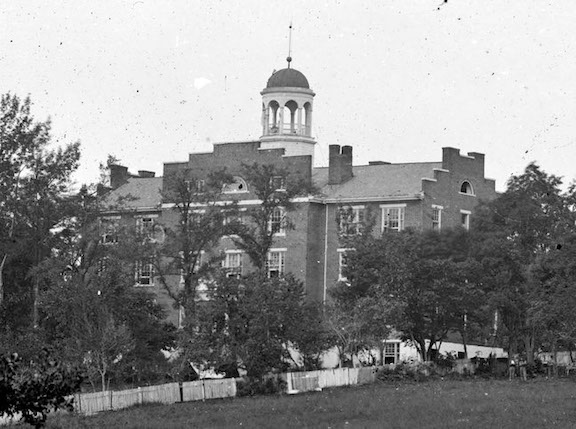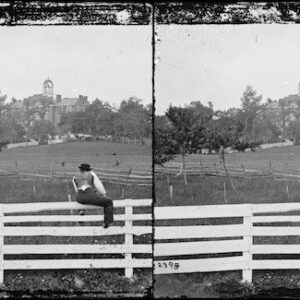Tag: Lutheran Theological Seminary (Gettysburg PA)
 Wikipedia says: The Lutheran Theological Seminary at Gettysburg (Gettysburg Seminary) was a seminary of the Evangelical Lutheran Church in America (ELCA) in Gettysburg, Pennsylvania. It was one of seven ELCA seminaries, one of the three seminaries in the Eastern Cluster of Lutheran Seminaries, and a member institution of the Washington Theological Consortium. Founded in 1826, it was the oldest continuing Lutheran seminary in the United States until it was merged with the Lutheran Theological Seminary at Philadelphia to become United Lutheran Seminary on July 1, 2017.
Wikipedia says: The Lutheran Theological Seminary at Gettysburg (Gettysburg Seminary) was a seminary of the Evangelical Lutheran Church in America (ELCA) in Gettysburg, Pennsylvania. It was one of seven ELCA seminaries, one of the three seminaries in the Eastern Cluster of Lutheran Seminaries, and a member institution of the Washington Theological Consortium. Founded in 1826, it was the oldest continuing Lutheran seminary in the United States until it was merged with the Lutheran Theological Seminary at Philadelphia to become United Lutheran Seminary on July 1, 2017.
The Gettysburg Seminary served the church as a pioneer in theological education creating among Lutheran seminaries the first faculty position in Christian Education (1926), the first teacher in sociology and psychology (1942), and the first in stewardship (1989). Gettysburg continued to add to its trail breaking in the American scene by granting tenure to a female professor (Bertha Paulssen, 1945) and graduating (Elizabeth Platz in 1965) the first woman to be ordained by an American Lutheran church body (ordained in 1970). Gettysburg Seminary was the first Lutheran seminary to admit an African American seminarian, Daniel Alexander Payne, in 1835.
During the battle of Gettysburg, the seminary, on a ridge west of the town, became a focal point of action on the first day of battle, 1 July 1863. The seminary gave its name to ‘Seminary Ridge,’ where the line of battle of the Confederate Army of Northern Virginia was formed on 2 and 3 July 1863.
History
At the 1820 formation of the General Synod of the Evangelical Lutheran Church in the United States, its constitution specified that the Synod form plans for a seminary or seminaries. Samuel Simon Schmucker, ordained in 1820, actively lobbied for the establishment of a seminary and began theological training for students in New Market, Virginia, at his parsonage. After hearing Schmucker speak in 1824 about his efforts, the Maryland-Virginia Synod recommended to the General Synod in 1825 that a seminary be established.
The board of directors first met on March 2, 1826, in Hagerstown, Maryland, the first order of business being to select a site for the seminary. They rejected proposals from Carlisle, Pennsylvania (at Dickinson College) and Hagerstown and the “Gettysburg Theological Seminary” was established on August 1, 1826. Schmucker was elected the first professor and the seminary opened with eight students on September 5, 1826, at the 1810 Gettysburg Academy building. In 1832 the seminary moved to its first building on the ridge west of the borough, which it now lends its name to (Seminary Ridge).
Role in the Battle of Gettysburg
On July 1, 1863 at 4 p.m., the Army of the Potomac was positioned at the seminary.
The Seminary building served as a lookout on 1 July 1863, the first day of battle. From the cupola, Brig. Gen. John Buford, commanding First Division, Cavalry Corps, Army of the Potomac, both observed the opening of the battle to the west of Seminary Ridge and witnessed the arrival of the I Corps under Maj. Gen. John Reynolds marching to his relief from the south.
By the late afternoon, the Union lines on McPherson’s Ridge, west of the seminary, were forced back to Seminary Ridge by Confederate troops of Heth’s and Pender’s Divisions. Before the troops could dig in on Seminary Ridge, a further attack by Pender’s Division broke the line. The I Corps streamed across Seminary Hill and through the town of Gettysburg, covered by a delaying action on the grounds by the famed Iron Brigade. The Confederate Army of Northern Virginia occupied the seminary grounds and held them until the Army’s retreat on 4 July 1863.
There was no further infantry combat on the seminary grounds, but it continued to play a prominent role in the battle. The seminary building had begun to be used as a field hospital for soldiers of both armies during the first day, and this continued throughout the engagement and after the battle was over. Artillery was posted on the hill and participated in action against Union artillery on Culp’s and Cemetery Hills on 2 and 3 July.
Confederate soldiers ransacked the house of seminary President Schmucker, an outspoken abolitionist. Confederate troops also used the seminary building cupola as a lookout, although there is no hard evidence that General Robert E. Lee, whose headquarters were just across the Cashtown Road to the north of the seminary, ever entered the cupola.
Showing the single result
